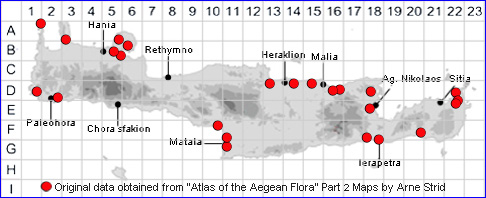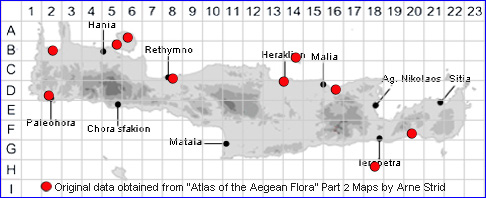
SPECIES DESCRIPTION
LIMONIUM VIRGATUM
Family:- PLUMBAGINACEAE/Subgen. LIMONIUM
Common Names:- None
Synonyms:- Limonium oleifolium, Statice oleifolia.
Meaning:- Limonium (Gr) Meadow-plant. A name used by the Greek physician
and botanist Dioscorides.
Virgatum (L) Twiggy, with straight slender twigs.
General description:- Laxly to densely caespitose perennial with stout taproot
and a branched woody stock, forming small cushions;
whole plant glabrous.
Stems:- Several.
a)10-30(-50) cm.
b) slender, dichotomously branched from below the middle, with some
sterile branches
c) hairless (glabrous)
Leaves:- Mainly in a basal rosette.
a) 30-55 x 4-9 mm
b) simple, linear-spathulate, 1-veined, on long basal branches,
c) green but drying in summer.
Flower:- Symmetrical radially,
a) pink or violet, with mauve or darker pink veins,
b) joined together in a branched inflorescences with numerous nonfloriferous
ramifications.
1) Corolla: 8 mm.
a) short tubed
b) petals, 5, partly fused, spread out.
c) stamens 5, opposite the petals.
2) Spikes 20-40 mm long.
a) unilateral.
b) dense, 2-3 flowered.
c) spiklets, curved.
3) Bracts, rusty-brown.
4) Calyx;
a) 5-6 mm,
b) ribs 5, ending above the base of the short and broad lobes.
Fruit:- Capsules surrounded by the corolla which remains attached, membranous
and dry after flowering.
Habitat:- Saltmarshes and rocky coasts, sometimes along roads, dry open
shrubby vegetation and ruderal habitats a short distance inland. 0-50(-300) m.
Distribution:- W Greece and Ionian Islands. - Widespread in the Mediterranean
region. Scattered around the the coastal areas of Crete.
Flowering time:- Mid-May to Sept.
Photos by:- Steve Lenton
FAMILY AND GENUS DESCRIPTIONS
PLUMBAGINACEAE
General description:- Herbs or shrubs.
Leaves:- Alternate or in basal rosettes, exstipulate.
Flowers:- Inflorescence usually cymose, often contracted into a capitulum, rarely
spike-like. Flowers actinomorphic, 5-merous, usually in bracteate spikelets. Calyx
tubular below, toothed (dentate) or lobed and at least slightly thin and dry (scarious)
and often pleated (plicate) distally, persistent. Petals united (connate) only at the
base, or the corolla with a usually short tube. Stamens united with the petals
(epipetalous). Styles 5, or 1 with 5 stigma-lobes. Ovary superior, 1-locular.
Fruit:- Dry, membranous, 1-seeded, surrounded by calyx, not splitting open to
release their seeds (indehiscent) or with circumscissile or irregular dehiscence.
LIMONIUM
General description:- Perennial, rarely annual, herbs or dwarf shrubs.
Leaves:- Simple, usually in a basal rosette, but densely leafy branches sometimes
present; leaves often absent at anthesis.
Flowers:- Inflorescence a corymbose panicle, with terminal, secund spikes, often
with non-flowering branches, usually with a reddish scale at the base of each
branch. Spikes of 3-bracteate, 1- to 5-flowered spikelets; inner and outer bracts
external to the spikelet, the middle one internal and often inconspicuous. Calyx
funnel-shaped (infundibuliform); limb thin and dry (scarious), usually coloured,
sometimes shortly dentate between the lobes. Corolla with a short tube, or the
petals united (connate) only at the base. Stamens inserted at the base of the
corolla. Styles 5, glabrous, free or connate at the base; stigmas thread-like
(filiform).
Fruit:- With circumscissile (opening by a slit running around the circumference) or
irregular splitting open to release the seeds (dehiscence).
1) Calyx infundibuliform.
2) Stamens inserted in base of corolla.
3) Styles 5, free or connate in basal half.
4) Fruit circumscissile towards apex or with irregular dehiscence.
5) Corolla-tube much shorter than lobes.
6) Spikes secund, the terminal not distinctly larger.
7) Stigmas filiform.
Subgen. LIMONIUM
General description:- Perennial herbs, rarely annuals or dwarf shrubs.
Leaves:- Entire, present at anthesis.
Flowers:- Petals connate at the base only.
Fruit:- With irregular dehiscence.
LIMONIUM AEGAEUM
Synonyms:- None
Meaning:- Aegeaum (L) Refers to the distribution of this species around the Aegean Sea.
Resembling Limonium virgatum, but differering in the following characters
1) Leaves, usually larger (20-90 x -15 mm), often falcate.
2) Stems, 15-70 cm, branched rom near base, with many sterile branches.
3) Spikelets, 2-7 flowered, often fan-shaped.
4) Calyx, 6-7.5 mm, with 5 ribs ending at the base of the lobes.
Click here for a more detailed description of this species.
Habitat:- Saltmarshes, rocky coasts and sandy beaches, occasionally a short distance inland, 0-20(-200) m.
Distribution:- Widespread along the Aegean coast of Greece and on many of the Aegean Islands. It also occurs sporadically in Turkey (West Anatolia). Fairly rare on Crete, scattered mainly around a few northern coastal habitats.
Flowering time:- Mainly June-August.
Photos by Christopher Cheiladakis
Synonyms:- None
Meaning:- Aegeaum (L) Refers to the distribution of this species around the Aegean Sea.
Resembling Limonium virgatum, but differering in the following characters
1) Leaves, usually larger (20-90 x -15 mm), often falcate.
2) Stems, 15-70 cm, branched rom near base, with many sterile branches.
3) Spikelets, 2-7 flowered, often fan-shaped.
4) Calyx, 6-7.5 mm, with 5 ribs ending at the base of the lobes.
Click here for a more detailed description of this species.
Habitat:- Saltmarshes, rocky coasts and sandy beaches, occasionally a short distance inland, 0-20(-200) m.
Distribution:- Widespread along the Aegean coast of Greece and on many of the Aegean Islands. It also occurs sporadically in Turkey (West Anatolia). Fairly rare on Crete, scattered mainly around a few northern coastal habitats.
Flowering time:- Mainly June-August.
Photos by Christopher Cheiladakis

